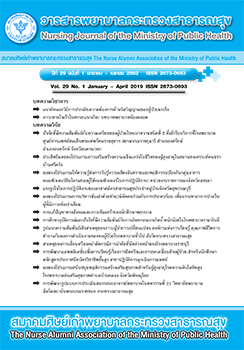Effects of an Education-Based Program on Hazard Perception and Preventive Behaviors of Computer Syndrome among Working Computer Users: Public Offices in Songkhla Town’s Area
Main Article Content
Abstract
This one group pretest and posttest quasi-experimental research aimed to examine the effects of an education-based program on hazard perception and preventive behaviors of computer syndrome among working computer users. The sample consisted of 98 computer users working in Songkhla Town’s Area. A questionnaire was used to collect data to assess hazard perception and preventive behaviors regarding computer syndrome. The Cronbach alpha coefficient used to test reliability yielded a value of .85. Data were analysed using mean, standard deviation, and dependent t-test. Research results were found as follows;
1) After program completion, the sample had a significantly higher mean score of hazard perception of computer syndrome as well as the mean scores of all three aspects than before participating in the program
(= 3.26, SD=0.36 and
= 2.44, SD=.36, p<.001).
2) After program completion, the sample had a significantly higher mean score of preventive behaviors regarding computer syndrome as well as the mean scores of all three aspects than before participating in the program ( =3.20, SD=0.30) (
=2.74, SD=.52, p<.001).
Therefore, educational institutes should apply education-based program to promote hazard perception and prevention of computer syndrome among computer users in both public and private sectors.
Article Details
บทความและรายงานวิจัยในวารสารพยาบาลกระทรวงสาธารณสุข เป็นความคิดเห็นของ ผู้เขียน มิใช่ของคณะผู้จัดทำ และมิใช่ความรับผิดชอบของสมาคมศิษย์เก่าพยาบาลกระทรวงสาธารณสุข ซึ่งสามารถนำไปอ้างอิงได้
References
2. Ministry of Digital Economy and Society. Digital Thailand. Bangkok: Ministry of Digital Economy and Society; 2016. (in Thai).
3. Karachot B. Computer Vision Syndrome. R&D Newsletter. 2016; 12(1):17-18. (in Thai).
4. PhonharnN, Ruengvoraboon S, Boonkaew K, Seewirat A. The physical symptoms that cccur from using computer of supporting staffs of Nakhonphanom University. Srinakharinwirot University. Journal of Science and Technology. 2014;6(12):26-38. (in Thai).
5. Thailand Institute of Occupational Safety and Health. Safety Thailand Safety Together [Internet]. 2016 [cited 2018 May 21]. Available from: https://www.tosh.or.th/index.php/tosh-news/project/21-safety-thailand. (in Thai).
6. Pokawinpudisnun R, Chanprasit C, Songkham W. Dust hazard risk perception and protection behaviors among ceramic factory workers. Journal of Health Science. 2009; 18(4):587-96. (in Thai).
7. Bernstein DA. Essentials of Psychology. Boston: Houghton Mifflin Company; 1999.
8. Becker MH. The health belief model and personal health behavior. Health Education monograpk. 1974;2(a):409-17.
9. Thai Health Promotion Foundation. Computer Vision Syndrome [Internet]. 2016 [cited 2018 May 12]. Available from: https://www.thaihealth.or.th/Content/27946%E0%B9%82%E0%B8%A3%E0%B8%84%E0%B8%84%E0%B8%AD%E0%B8%A1%E0%B8%9E%E0%B8%. (in Thai).
10. Sakulthaew C. Factors Related to Safety Behavior in Chemistry Laboratory among Undergradeuate Students. [Master Thesis of Public Health].Bangkok. Thammasat University. 2016. (in Thai).
11. Thongmeekhaun T, Sungkhachat B, Kitrungroap T, Juntaveemuang V, Wattanasart T, Meena S.Computer related health problems: risk perception in protection behaviors among supporting staffs. The Southern College Network Journal of Nursing and Public Health. 2018;5(2):258-71. (in Thai).
12. Krejcie RV, Morgan DW. Determining sample size for research activities. Educational and Psychological measurement. University of Minnesota; 1970.
13. Cronbach LJ. Essentials of psychological testing. 3rded. New York: Harper & Row; 1951.
14. Meemungkang Threraphon Thephasadin na Ayuthya P, Shueysai S. Factors Affecting the Employees’ Awareness of the Safety System in the Electric Motor Spare Parts Factory. Journal of Industrial Education.2011; 5(2):57-67. (in Thai).
15. Wonginyou N, Inmoung Y. Assessment of environmental and health risk perception of salt pot workers at Kud-Rea-Khom Sub-District, Wanonniwat District, Sakon Nakhon Province. KKU research journal. 2012;17(6):1012-27. (in Thai).
16. Pender NJ, Murdaugh CL, Parsons,MA. Health Promotion in Nursing Practice. 5th ed. New Jersey: Pearson Prentice Hall; (2006).
17. Khampalikit S, BarameeJ. Teaching Guide for Health Promotion in Nursing Science Program. KhonKaen: KlungnanaPrintery; 2012. (in Thai).
18. Pholyiam R, Wattananukulkiat S. Effect of health belief based education program on health behavioramong pregnant women at risk for gestational diabetes mellitus. The Journal of Baromarajonani College of Nusing, Nakhonratchasima. 2016;22(1):77-92. (in Thai).
19. Khongseua P, Tantikosoom P, Ua-Kit N. The effects of educative supportive nursing program on dietary behaviors among patients after percutaneous transluminal coronary intervention. Kuakarun Journal of Nursing. 2014; 21(extra):168-85. (in Thai).

